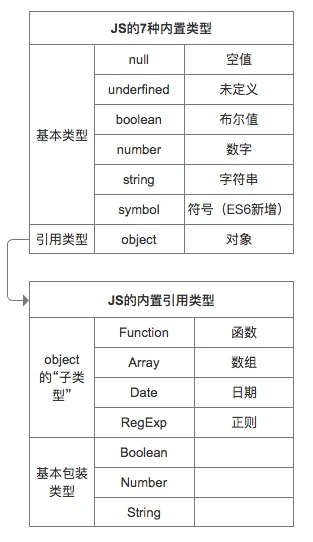数据类型的判断
Zzongke 5/23/2022 JavaScript
# 一、基本数据类型
JS 中七种内置类型(null,undefined,boolean,number,string,symbol,object)又分为两大类型
# 两大类型:
- 基本类型:null,undefined,boolean,number,string,symbol
- 引用类型 Object:Array,Function,Date,RegExp 等

# 二、数据类型的判断
- typeof:能判断所有值类型、函数。不可对 null、对象、数组进行精确判断,因为都返回
object。
console.log(typeof undefined); // undefined
console.log(typeof 2); // number
console.log(typeof true); // boolean
console.log(typeof "str"); // string
console.log(typeof Symbol("foo")); // symbol
console.log(typeof 2172141653n); // bigint
console.log(typeof function() {}); // function
// 不能判别
console.log(typeof []); // object
console.log(typeof {}); // object
console.log(typeof null); // object
1
2
3
4
5
6
7
8
9
10
11
2
3
4
5
6
7
8
9
10
11
- instanceof:能判断对象类型,不能判断基本数据类型,其内部运行机制是判断在其原型链中能否找到该类型的原型。比如考虑以下代码:
class People {}
class Student extends People {}
const vortesnail = new Student();
console.log(vortesnail instanceof People); // true
console.log(vortesnail instanceof Student); // true
1
2
3
4
5
6
7
2
3
4
5
6
7
其实现就是顺着原型链去找,如果能找到对应的 Xxxxx.prototype 即为 true 。比如这里的 vortesnail 作为实例,顺着原型链能找到 Student.prototype 及 People.prototype ,所以都为 true 。
- Object.prototype.toString.call():所有原始数据类型都是能判断的,还有 Error 对象,Date 对象等。
Object.prototype.toString.call(2); // "[object Number]"
Object.prototype.toString.call(""); // "[object String]"
Object.prototype.toString.call(true); // "[object Boolean]"
Object.prototype.toString.call(undefined); // "[object Undefined]"
Object.prototype.toString.call(null); // "[object Null]"
Object.prototype.toString.call(Math); // "[object Math]"
Object.prototype.toString.call({}); // "[object Object]"
Object.prototype.toString.call([]); // "[object Array]"
Object.prototype.toString.call(function() {}); // "[object Function]"
1
2
3
4
5
6
7
8
9
2
3
4
5
6
7
8
9
在面试中有一个经常被问的问题就是:如何判断变量是否为数组?
Array.isArray(arr); // true
arr.__proto__ === Array.prototype; // true
arr instanceof Array; // true
Object.prototype.toString.call(arr); // "[object Array]"
function toRawType(value) {
return Object.prototype.toString
.call(value)
.slice(8, -1)
.toLowerCase();
}
1
2
3
4
5
6
7
8
9
10
11
2
3
4
5
6
7
8
9
10
11